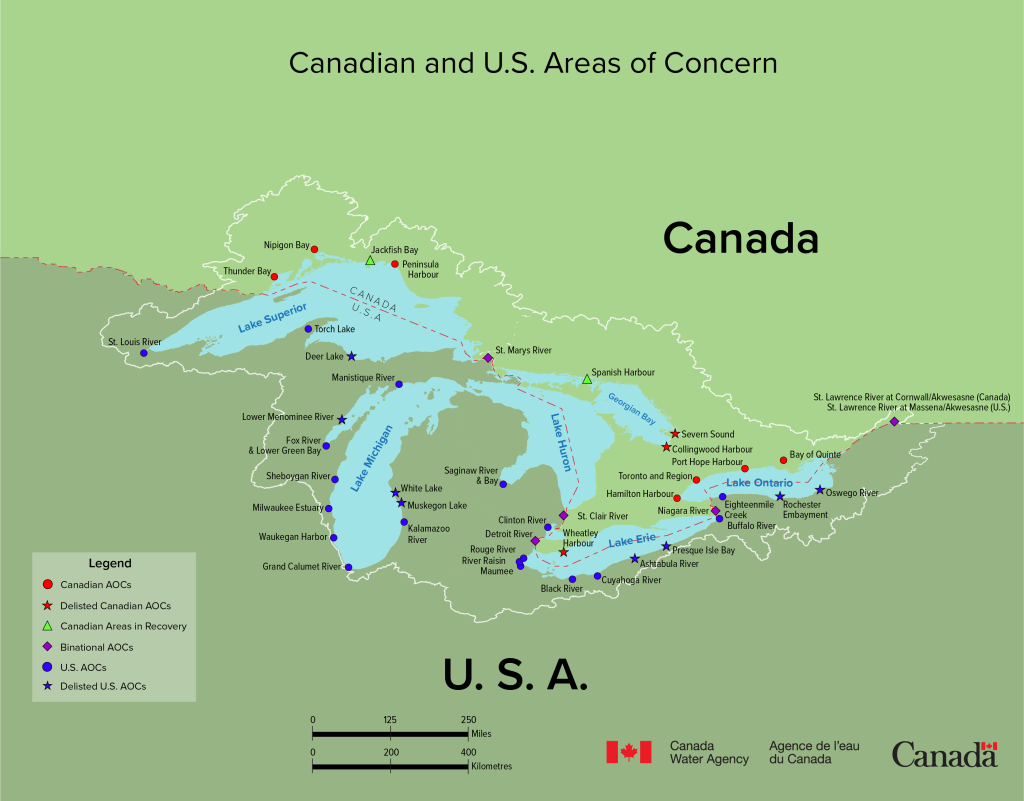Areas of Concern (Annex 1)
Through the Areas of Concern Annex of the 2012 Great Lakes Water Quality Agreement, Canada and the United States have committed to:
“… contribute to the achievement of the General and Specific Objectives of this Agreement by restoring beneficial uses that have become impaired due to local conditions at Areas of Concern (AOCs), through the development and implementation of Remedial Action Plans (RAPs) for each AOC designated pursuant to this Agreement.”
Annex 1 of the Agreement defines an AOC as a geographic area designated by Canada or the United States where significant impairment of beneficial uses has occurred as a result of human activities at the local level. Impairment of a beneficial use is a reduction in the chemical, physical or biological integrity of the waters of the Great Lakes sufficient to cause any of 14 specific problems (beneficial use impairments) described in the Annex 1 of the Agreement.
Pursuant to the 1987 Agreement, 43 locations were formally identified as AOCs by Canada and the United States, as shown on the map below: 12 in Canada, 26 in the United States and five binational AOCs that are shared by the two countries. Work to clean up AOCs is accomplished domestically through programs led by the Canada Water Agency and the U.S. Environmental Protection Agency, with collaboration from other federal departments and agencies, and from provincial, state and local partners. Significant progress has been made in all AOCs, . To date, 10 AOCs have been designated as “delisted”, meaning that all remedial actions are complete and all beneficial uses are restored. An additional 2 AOCs have been designated as an “AOC in recovery”, meaning that all remedial actions are complete and monitoring is underway to track the natural restoration of beneficial uses. Progress in the remaining AOCs continues to be a priority for both countries under the 2012 Agreement.

Key Commitments
Canada and the United States agree to:
- Ensure that Remedial Action Plans are developed, periodically updated, and implemented for each AOC. Each Plan will:
- identify beneficial use impairments and causes;
- include criteria for restoring beneficial uses, established in consultation with the local community;
- identify remedial measures to be taken and entities responsible for implementing these measures;
- summarize the remedial measures taken and the status of beneficial uses; and
- describe surveillance and monitoring processes.
- Make Remedial Action Plans and their updates available to the International Joint Commission and the public;
- Solicit reviews and comments from various governmental and non-governmental interests, and the International Joint Commission prior to designating an AOC as one in recovery, and prior to the removal of a designation as an AOC.
For additional information on the focus of actions under this annex, consult the current Priorities for Science and Action. The Priorities are based on an evaluation of the State of the Great Lakes, with input from the Great Lakes Executive Committee, participants at the Great Lakes Public Forum, and recommendations of the International Joint Commission.
Every six months, progress on this annex is reported at the Great Lakes Executive Committee meetings. Accomplishments will be described in the Progress Report of the Parties every three years, with the first expected in 2016.
Implementation
Implementation of this annex is co-led by the Canada Water Agency and the United States Environmental Protection Agency.
As required, time-limited task teams can also be created to focus efforts on a priority issue or project, and will be disbanded when work is complete.